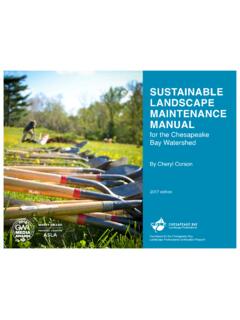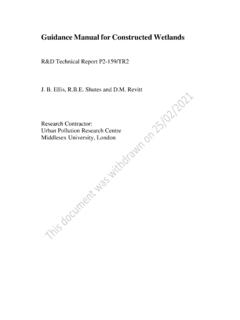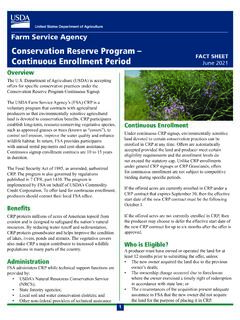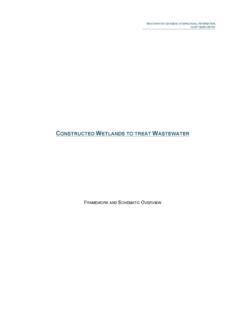Transcription of SUSTAINABLE LANDSCAPE MAINTENANCE MANUAL
1 SUSTAINABLE LANDSCAPE MAINTENANCE MANUALfor the Chesapeake Bay WatershedBy Cheryl CorsonDeveloped for the Chesapeake Bay LANDSCAPE Professional Certification Program2017 editionSUSTAINABLE LANDSCAPE MAINTENANCE MANUALfor the Chesapeake Bay WatershedBy Cheryl Corson2017 editionDeveloped for the Chesapeake Bay LANDSCAPE Professional Certification 2017 by the Chesapeake Conservation Landscaping CouncilAll rights reserved. See page iii for reproduction publication was developed for the Chesapeake Bay LANDSCAPE Professional Certification funding to support development of this MANUAL was provided by the District of Columbia Department of Energy & Environment. The Low Impact Development Center served as fiscal sponsor for the Maryland Sea Grant College program communications team provided copyediting and graphic design for this photo courtesy of the Alliance for the Chesapeake OF CONTENTSCONTENTSF oreword.
2 IPreface ..iiHow to Use This MANUAL ..iiiTable of Abbreviations ..ivIntroduction ..viHUMAN SYSTEMS ..1 Section 1: Inventory, Assessment, and Prioritization ..11 .1 Inventory .. Site Assessment .. Prioritization ..31 .4 References ..4 Section 2: Laws, Regulations, and Permitting .. Regulatory Overview .. Project Approval Framework .. Typically Regulated LANDSCAPE MAINTENANCE Activities .. Where to Find Information on Laws and Regulations ..6 Table 1: State Environmental Agencies .. Selected Nonprofit Sector Resources ..82 .6 References ..8 Section 3: Working on Historic Sites .. Historic Sites Overview .. Historic landscapes in Our Region .. Selected Public Agency Contacts for Historic Properties ..10 Table 2: State Historic Preservation Agencies .. Case Study .. 113 .5 References.
3 11 Section 4: Strategy, Scheduling, and Specifications .. Strategy ..12 Table 3: Example of LMA Worksheet ..13 SUSTAINABLE LANDSCAPE MAINTENANCE MANUAL FOR THE CHESAPEAKE BAY Scheduling .. Specifications ..144 .4 References ..15 Section 5: Labor and Cost Estimating .. Training and Skills .. Business Models .. Cost Estimating ..17 Table 4: LANDSCAPE MAINTENANCE Cost/Benefit Matrix ..185 .4 References ..18 Section 6: Project Documentation and Templates .. Overall Site Inspection Rationale and Templates ..19 Table 5: Expanded LMA Worksheet with New Site Inspection ..20 Table 6: Site-Wide General LANDSCAPE MAINTENANCE Assessment .. Annual MAINTENANCE Task Outline and Template ..22 Table 7: Annual Task Schedule Template ..226 .3 References ..23 TOOLS AND WORKING METHODS ..25 Section 7: Tools and Equipment.
4 Choosing Tools and Equipment .. When to Use Equipment .. Maintaining Tools and Equipment ..267 .4 References ..26 Section 8: Safety and Teamwork .. General Safety Resources .. Specific LANDSCAPE Safety Concerns .. The Importance of Teamwork ..288 .4 References ..29 Section 9: Using and Procuring Materials Sustainably .. Selecting Materials for Sustainability .. Using Fertilizers .. Procuring Mulch ..319 .4 References ..31 TABLE OF CONTENTSS ection 10: Proprietary Products and Systems .. Identifying Proprietary Products ..32 NATURAL SYSTEMS ..35 Section 11: Water .. Water Use Considerations .. Irrigation Recommendations ..3611 .4 References ..36 Section 12: Soil .. Soil Specifications .. Soil Testing .. Soil Amendments ..3812 .4 References ..38 Section 13: Erosion and Sediment Control.
5 State Regulations .. Monitoring for Sedimentation .. Sediment Removal and Disposal ..4013 .4 References ..40 Section 14: Integrated Pest Management ..4114 .1 What is IPM? ..4114 .2 IPM Methods .. Specifying IPM ..4214 .4 References ..43 PLANT MATERIALS ..45 Section 15: Plants and Vegetated Areas ..4515 .1 Plant Health Care ..4515 .2 PHC Best Practices .. Mulch Best Practices .. Pruning Best Practices .. Plant Removal, Disposal, and Replacement ..4815 .6 References ..48 SUSTAINABLE LANDSCAPE MAINTENANCE MANUAL FOR THE CHESAPEAKE BAY WATERSHEDS ection 16: Trees .. Trees Need Our Help .. Simple, Effective Tree MAINTENANCE .. Tree Pruning Basics .. When to Call an ISA-Certified Arborist ..5116 .5 References ..52 Section 17: Invasive Species Identification, Removal, and Control.
6 Invasive Plant Definition, Recognition, and Reproduction .. Public Agency Assistance and Regulation ..5417 .3 Control Methods .. Common Regional Invasive Plants ..55 Table 8: Selected Common Chesapeake Bay Watershed Non-Native Invasive Plants ..5517 .5 References ..56 Section 18: Lawn Care .. Lawns and the Chesapeake Bay Watershed .. Legislation and Regulation .. Lawn Care Methods ..5818 .4 References ..59 Section 19: Vegetated BMP MAINTENANCE .. Topic Organization and Primary Sources .. Rain Gardens and Open Channels ..60 Table 9: Typical MAINTENANCE Tasks for Bioretention Practices ..61 Table 10: Bioretention Condition Standard Definitions ..63 Table 11: Bioretention Evaluation Worksheet .. Conservation Landscaping, Riparian Buffers, and Vegetated Filter Strips ..67 Table 12: Typical MAINTENANCE Activities for Conservation landscapes .
7 67 Table 13: Typical MAINTENANCE Activities for Vegetated Filter Strips ..6819 .4 Green Roofs ..68 Table 14: Typical MAINTENANCE Activities for Green Roofs ..68 TABLE OF Living Walls ..7019 .6 Wetlands and Wet Ponds ..70 Table 15: Typical Constructed Wetlands MAINTENANCE Activities ..71 Table 16: Typical Wet Pond MAINTENANCE Activities ..7219 .7 References ..72 HARDSCAPES ..75 Section 20: Hardscape BMP MAINTENANCE .. Hardscape BMP Overview .. Rainwater Harvesting Systems ..75 Table 17: Typical MAINTENANCE Tasks for Rainwater Harvesting Systems .. Infiltration Basins and Trenches ..78 Table 18: Typical MAINTENANCE Activities for Infiltration Practices .. Paving Systems ..80 Table 19: Typical MAINTENANCE Tasks for Permeable Pavement Practices ..8020 .5 References ..82 About the Author ..83 About the Chesapeake Bay LANDSCAPE Professional Program.
8 83 SUSTAINABLE LANDSCAPE MAINTENANCE MANUAL FOR THE CHESAPEAKE BAY WATERSHEDiFOREWORDOne of the most wonderful attributes of the planted LANDSCAPE is that it is beholden to the local. The site conditions, including soils, flora, fauna, climate, and even human culture, are primary determinants of our sense of place, and the delimiting factors describing our universe of possibilities in SUSTAINABLE landscapes . However, the very locality that gives landscapes their unique magic presents practical concerns in the application of best management practices. As any horticulturist who has tried to garden a few dozen miles from where they first learned will know, the plants behave differently in different places. Perhaps more importantly for SUSTAINABLE landscapes , the native ecosystems and their constituent communities are different from place to place. Consequently, it is challenging to develop highly detailed SUSTAINABLE LANDSCAPE practices that are applicable to large geographic areas.
9 While we have wonderful national sustainability programs such as SITES and LEED , it is critically important to augment these programs with locally appropriate practices. Local land managers, horticulturists, arborists, and designers have significant knowledge that is required to simultaneously achieve sustainability, aesthetic, and performance goals, especially for sensitive interconnected ecosystems such as the Chesapeake Bay Watershed. As we seek to celebrate the local wherever we maintain SUSTAINABLE landscapes , we should also celebrate the practitioner who aggregates and shares local knowledge so that we can all be better stewards of our regions. We are fortunate that Cheryl Corson, an accomplished LANDSCAPE architect, LANDSCAPE MAINTENANCE expert, and a professional living and working in the Chesapeake Bay region, has produced this excellent SUSTAINABLE LANDSCAPE MAINTENANCE MANUAL for the Chesapeake Bay Watershed for the Chesapeake Bay LANDSCAPE Professional Certification Program.
10 Cheryl is an able sustainability educator and guide with a deep understanding of the ecology and best management practices of the region. My institution, the Botanic Garden, has invited her to teach LANDSCAPE design workshops many times as we work to create a network of SUSTAINABLE LANDSCAPE practitioners. In this MANUAL , Cheryl draws on her considerable experience to provide a comprehensive framework for the MAINTENANCE of SUSTAINABLE landscapes , including overviews and references for relevant regulations and best management practices specific to the Chesapeake Bay watershed. The reader will learn everything: from the planning and business side of SUSTAINABLE LANDSCAPE MAINTENANCE to simple and effective tree MAINTENANCE to the basics of permeable paving systems. In addition, this MANUAL prepares the reader for certification as a Chesapeake Bay LANDSCAPE Professional.









